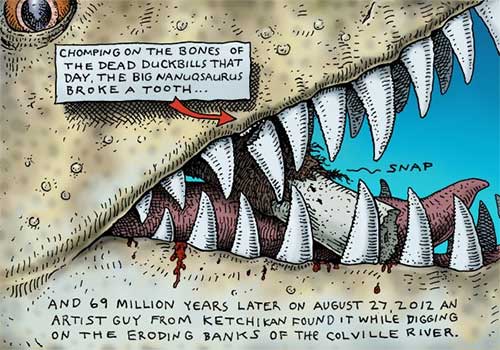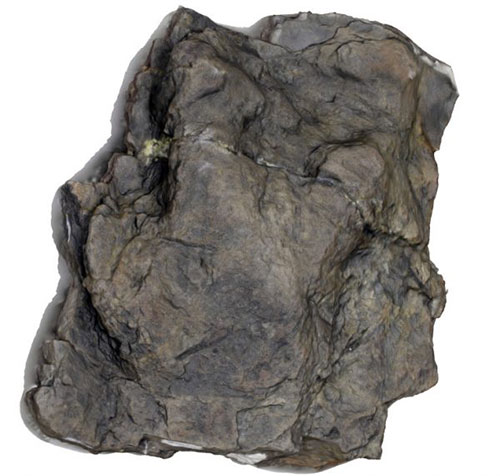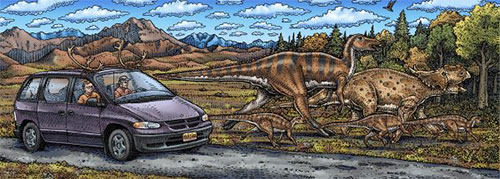Museum fossils help artist tell the story of life on EarthBy THERESA BAKKERSeptember 28, 2017
A new exhibit featuring fossils from the earth sciences collection at the University of Alaska Museum of the North tells the story of an artist and a paleontologist who don’t just travel through space together, they travel through geological time. In “Cruisin’ the Fossil Coastline,” now on display at the Anchorage Museum, Alaska artist Ray Troll uses his skills to bring to life the past buried in the outcrops and rocky ledges of the West Coast of North America.
The coast was once home to an exotic array of animals whose remains have been discovered along 10,000 miles of shoreline, from the southern extremes of California to the now extinct polar forests of Alaska’s North Slope. Troll and collaborator Kirk Johnson, the director of the Smithsonian National Museum of Natural History, have been friends for a couple of decades. In that time, they have traveled all around North America looking for fossils and uncovering the animals that once lived on Earth. One of those stories is told in the painting “Broke a Tooth,” based on a discovery made when Troll accompanied the earth sciences team from the UA Museum of the North on an expedition to the North Slope in 2012. “There we were on the Colville River in the Arctic,” Troll said. “I was blown away by the number of bones coming out of the Liscomb Bone Bed where scientists have found thousands of fossils. I could just feel my imagination running wild. Then I found the tyrannosaur tooth.”
The discovery belonged to a newly described species that only lived in Alaska, Nanuqsaurus hoglundi, the genus name of which means “polar bear lizard.” The extinct species of carnivorous tyrannosaur was described from a handful of bones found on the North Slope. Troll imagined it was left behind when the predator was chomping on the bones of Ugrunaaluk kuukpikensis, a duckbilled dinosaur recently described by museum scientists. That tooth and the painting it inspired are on display in the exhibit, along with many other fossils and more than a hundred original artworks by Troll. Patrick Druckenmiller, earth sciences curator, said Alaska fossils are very hard to come by and collect, so this exhibit is special. “Our current knowledge of who/what lived in this state in ancient times is equivalent to what it was like in the American West a hundred years ago, before many people had scientifically explored the area,” he said. “The bottom line is that we just don’t know much yet about Alaska’s fossil potential, so whatever we find is typically a new species and very cool because it lived at high latitudes.” That’s why the museum loaned many different specimens from the collection to the exhibit. One of them is the entire lower jaw of Alaska’s most complete mastodon skeleton. Also, the museum loaned dozens of Pleistocene mammal bones from the mammoth, steppe bison, horse and other species that lived in the Interior during the Ice Age. In the exhibit, visitors will be able to examine this treasure trove of bones in what Troll is calling a fossil terrarium. The number and variety of specimens on display will emphasize the great abundance of these animals found in Alaska. “I was inspired by the fossil collecting potential around Fairbanks,” Troll said. “I told Pat we have to do this and he offered some of the bones from the museum’s teaching collection. There’s even a lion bone in there.”
Druckenmiller said one of the coolest fossils on display in the exhibit is the footprint of a giant bird the size of a human. It was found in the Chickaloon formation near Palmer. The animal lived about 55 million years ago, after dinosaurs became extinct. “That’s when some of the largest land animals were not mammals but birds. This particular one may have been a top predator in the palm-dominated forests of southern Alaska at that time.” Scientists and artists are both motivated by the same thing, Troll said. “Curiosity is what drives us. I don’t buy the divisions between our work. I’ve been a science nerd all my life, fascinated by prehistory,” he said. “When I’m with Pat or Kirk, we can get lost in the details of that world. It takes curiosity to drive research.” Druckenmiller agrees. He said artists like Troll depict what these animals look like in real life, helping to advance our understanding of what was here long before humans. “Without that contribution, our job as paleontologists would be incomplete,” he said. “They help us communicate our research to other scientists and the public alike on extinct plants, animals and landscapes in ways that we never could through academic publications.” The exhibit “Cruisin’ the Fossil Coastline” will be on display at the Anchorage Museum through September 2018.
Representations of fact and opinions in comments posted are solely those of the individual posters and do not represent the opinions of Sitnews.
|
||||||



